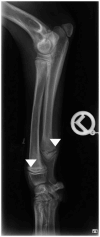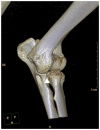Osteoarthritis, adipokines and the translational research potential in small animal patients
- PMID: 38831954
- PMCID: PMC11144893
- DOI: 10.3389/fvets.2024.1193702
Osteoarthritis, adipokines and the translational research potential in small animal patients
Abstract
Osteoartritis (OA) is a debilitating disease affecting both humans and animals. In the early stages, OA is characterized by damage to the extracellular matrix (ECM) and apoptosis and depletion of chondrocytes. OA progression is characterized by hyaline cartilage loss, chondrophyte and osteophyte formation, thickening of the joint capsule and function loss in the later stages. As the regenerative potential of cartilage is very limited and osteoarthritic changes are irreversible, prevention of OA, modulation of existing osteoarthritic joint inflammation, reducing joint pain and supporting joint function are the only options. Progression of OA and pain may necessitate surgical intervention with joint replacement or arthrodesis as end-stage procedures. In human medicine, the role of adipokines in the development and progression of OA has received increasing interest. At present, the known adipokines include leptin, adiponectin, visfatin, resistin, progranulin, chemerin, lipocalin-2, vaspin, omentin-1 and nesfatin. Adipokines have been demonstrated to play a pivotal role in joint homeostasis by modulating anabolic and catabolic balance, autophagy, apoptosis and inflammatory responses. In small animals, in terms of dogs and cats, naturally occurring OA has been clearly demonstrated as a clinical problem. Similar to humans, the etiology of OA is multifactorial and has not been fully elucidated. Humans, dogs and cats share many joint related degenerative diseases leading to OA. In this review, joint homeostasis, OA, adipokines and the most common joint diseases in small animals leading to naturally occurring OA and their relation with adipokines are discussed. The purpose of this review is highlighting the translational potential of OA and adipokines research in small animal patients.
Keywords: adipokines; dogs and cats; joint disease; joint homeostasis; osteoarthritis; translational research.
Copyright © 2024 Theyse and Mazur.
Conflict of interest statement
The authors declare that the research was conducted in the absence of any commercial or financial relationships that could be construed as a potential conflict of interest.
Figures






Similar articles
-
The Role of Adipokines between Genders in the Pathogenesis of Osteoarthritis.Int J Mol Sci. 2024 Oct 9;25(19):10865. doi: 10.3390/ijms251910865. Int J Mol Sci. 2024. PMID: 39409194 Free PMC article. Review.
-
Expression of adipokines in osteoarthritis osteophytes and their effect on osteoblasts.Matrix Biol. 2017 Oct;62:75-91. doi: 10.1016/j.matbio.2016.11.005. Epub 2016 Nov 22. Matrix Biol. 2017. PMID: 27884778
-
The Adipokine Network in Rheumatic Joint Diseases.Int J Mol Sci. 2019 Aug 22;20(17):4091. doi: 10.3390/ijms20174091. Int J Mol Sci. 2019. PMID: 31443349 Free PMC article. Review.
-
Adipokines: Biomarkers for osteoarthritis?World J Orthop. 2014 Jul 18;5(3):319-27. doi: 10.5312/wjo.v5.i3.319. eCollection 2014 Jul 18. World J Orthop. 2014. PMID: 25035835 Free PMC article. Review.
-
The emerging role of adipokines in osteoarthritis: a narrative review.Mol Biol Rep. 2011 Feb;38(2):873-8. doi: 10.1007/s11033-010-0179-y. Epub 2010 May 18. Mol Biol Rep. 2011. PMID: 20480243 Review.
Cited by
-
An olive oil-derived NAE mixture (Olaliamid®) improves liver and cardiovascular health, and decreases meta-inflammation in naturally obese dogs: a double-blind, randomized, placebo-controlled study.BMC Vet Res. 2025 Aug 6;21(1):505. doi: 10.1186/s12917-025-04946-y. BMC Vet Res. 2025. PMID: 40764576 Free PMC article.
References
Publication types
LinkOut - more resources
Full Text Sources
Research Materials
Miscellaneous

